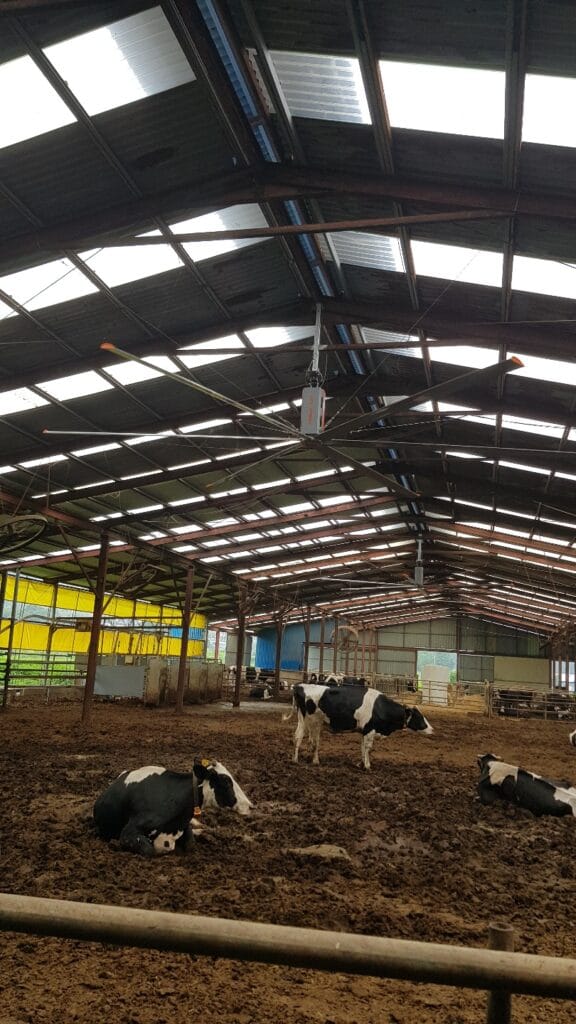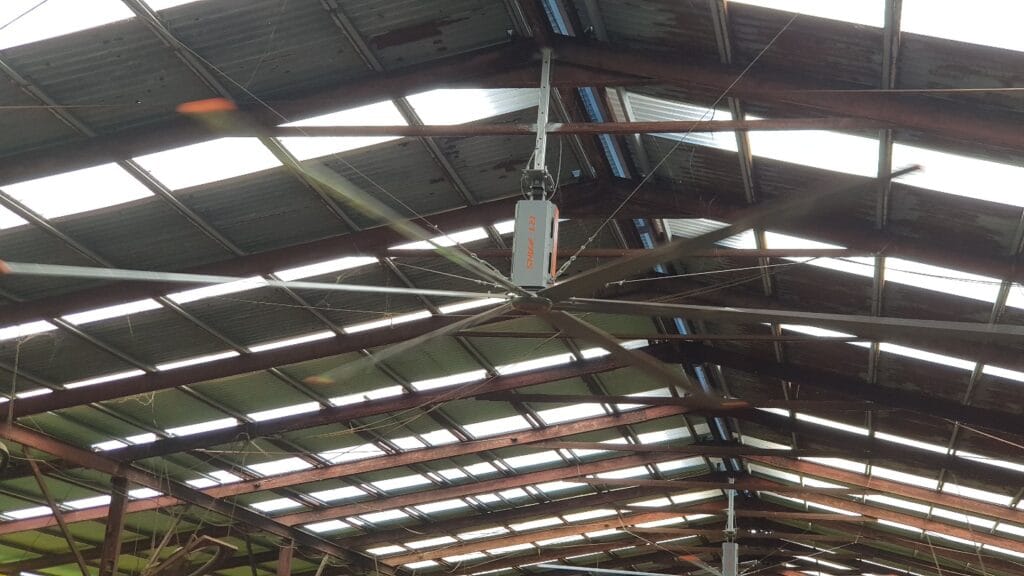Calf barns are important in raising the future generation of dairy herds, yet improper ventilation may make them breeding areas of pneumonia, a major killer and growth retardant of the calves. Cow calves have weak immune systems and are especially susceptible to respiratory illnesses in damp stuffy air. Ceiling fan-equipped calf barns, particularly HVLS calf barns, can greatly decrease chances of pneumonia by increasing airflow, lowering humidity and reducing airborne pathogen spread. These calf barn ventilation fans can help prevent calf pneumonia airflow and calf health with the ceiling fans and by improving the quality of air in the calf barns. This is a crucial investment on the part of dairy farmers, calf barn managers, veterinarians and livestock consultants. RTFANS has revolutionized barns around the world with more than 20 years of experience in ventilation systems. We will discuss why calves are susceptible, why ventilation is important, the health-saving effects of fans, economic benefits, complementary measures, a case-study, and frequently asked questions.
Why Calves Are Vulnerable to Pneumonia
The health risk of pneumonia in barns is a persistent problem because of the unique health risk faced by calves, especially those that are less than three months of age.
Immature Immune Systems
Calves are born with immature immune system, leaving them very prone to respiratory diseases. According to veterinary research, 15-30 percent of dairy calves get pneumonia and death rates can be up to 5-20 percent in poorly kept barns. They have less efficient lungs to eliminate pathogens, and they become more vulnerable.

Close Housing in Barns
The number of animals housed in calf barns is usually dozens, increasing the risk of contact with such pathogens as Pasteurella and Mycoplasma, which are transmitted by air droplets. Congested pens with inadequate air circulation expose bacteria and increase the rate of infection by 20-30.
Poor Airflow and Buildup of Ammonia, Moisture, and Bacteria
Lack of ventilation leads to manured ammonia exceeding 10 ppm, which irritates the lungs and risk of pneumonia doubles. Bacterial growth occurs in high humidity (>60%) through respiration and bedding and the stagnant air traps pathogens, according to studies of animal health.
The Role of Ventilation in Disease Prevention
Ventilation Successful ventilation is a foundation of pneumonia risk calves barn ventilation, eliminating disease inducers and enhancing calf comfort.
Fresh Air Exchange Reduces Harmful Gases
Ammonia and CO2 get diluted by ventilation up to 15-25% and maintain levels at harmful levels (10 ppm ammonia, 1,000 ppm CO2). ASABE guidelines suggest 100-200 cubic feet per minute (CFM) of fresh air per calf.
Even Airflow Prevents Cold Drafts
Good air movement eliminates pathogens, and prevents cold drafts that can cause stress to calves. Stable circulation maintains a constant temperature (50-68oF), minimizing breathing stress.
Stabilizing Humidity and Temperature for Comfort
Ventilation reduces the humidity by 10-15%, eliminating wet bedding which supports bacteria. The stable conditions contribute to the comfort of the calves and minimize infections caused by stress.
How Ceiling Fans Support Calf Health
HVLS ceiling fans, 8-24 feet in diameter, adjust up to 400,000 CFM at low speeds (50-100 RPM) and are available as custom solutions to calf barn airflow applications.

HVLS Fans Circulate Large Volumes of Air Evenly
One HVLS fan serves 10,000- 22,000 square feet, depending on the uniformity of airflow between pens. This disperses pathogens and ammonia and decreases the risk of pneumonia by 20-30%.
Reduce Condensation and Pathogen Spread
Evaporation by fans reduces the humidity in the air by 10-15 percent, drying out bedding and floors. This inhibits the growth of bacteria, which is consistent with infection prevention recommended by the veterinary profession.
Quiet Operation Prevents Stress
HVLS fans run at 35 dB or below, which is quieter than a whisper, and does not frighten calves like traditional fans (50-60 dB). This helps to ensure ceiling fans calf health as the stress hormones would be reduced.
Economic Impact of Pneumonia in Calves
Ventilation is important as pneumonia causes major financial implications.
Higher Veterinary Costs
It costs between 100-300 per calf to treat pneumonia, and a 100-calf barn incurs between 5,000 and 15,000 per year. Preventative ventilation helps to save 20-30 of such costs.
Reduced Growth Rates and Feed Efficiency
Pneumonia reduces weaning gain by an average of 2-4 weeks, reduces feed efficiency by 5-10 percent, and reduces weight gain by 10-20 percent. This affects productivity in the long term, which is costly by 50 to 100 calf.
Long-Term Milk Yield Reduction
Heifers that have pneumonia generate 5-10% less milk (300-1,000 pounds per lactation), with a lifetime cost of $5,000-10,000 in 100 cow herd.
Case Example: A Dairy Farm’s Success
The Ontario dairy farm of 120 cows reported 25 percent pneumonia rates in their calf barn, with a humidity of 70 percent and 15 ppm ammonia. Calf death was at 10 per cent, equivalent to $10,000 in losses and veterinary expenses each year. The installation of two 16-foot HVLS fans enhanced the ability of ventilation to prevent calf pneumonia by lowering the humidity to 55% and the ammonia concentration to 8 ppm. Cases of pneumonia decreased by 20 per cent, mortality was reduced to 3 per cent, and weight gain was increased by 15 per cent (0.5 pounds per day). It saved 3,000 in vet expenses and 7,000 in productivity yielding an annual savings and ROI in 18 months, demonstrating that ceiling fans can enhance air quality in calf barns.
Complementary Strategies
HVLS fans should be most effective in combination with other practices:
- Proper Bedding Management: Dry clean bedding lowers moisture, an aspect that fans cannot manage.
- Disinfection: Cleaning of pens regularly prevents the accumulation of pathogens, which increases the efficiency of fans.
- Biosecurity: Visitor restrictions and isolation of sick calves minimizes disease transmission, and fans help improve air quality.
FAQ: Common Questions About Calf Barn Ventilation
- Can ceiling fans alone prevent pneumonia in calves?
None, but they minimize risk by 20-30% with improved airflow; combine with bedding and biosecurity to optimize pneumonia risk calves barn ventilation. - Do fans make barns too drafty for young calves?
No, low speed airflow (50-100 RPM) of HVLS fans eliminates drafts and provides calf barn airflow solutions without stress. - Are HVLS fans suitable for small calf barns?
Yes, smaller HVLS models (8-12 feet) cover 5,000-10,000 square feet, which are best fans in young cattle barns. - How do fans improve calf air quality?
Fans can be used to ensure high quality air in calf barns by diluting ammonia and pathogens 15-25 times.
Conclusion
Pneumonia is a serious danger to the health of calves, and to the profitability of the farm, but adequate ventilation can protect young livestock. HVLS fans remove moisture, distribute airborne contaminants and enhance comfort, which is essential to calf barn ventilation fans. Commercial ceiling fans should be incorporated into calf barns by dairy farmers as a low maintenance, cost effective way to decrease the risks of pneumonia, increase calf survival and achieve long-term productivity of herd. RTFANS is a company that provides customized HVLS solutions with 20+ years of experience. Get in touch with us today to secure your calves- the future of your herd is on them.
